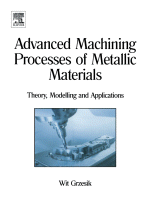Browse content
Table of contents
Actions for selected chapters
- Full text access
- Book chapterNo access
Chapter One - Introduction
Pages 1-3 - Book chapterNo access
Chapter Two - Metal Cutting Operations and Terminology
Pages 5-15 - Book chapterNo access
Chapter Three - Trends in Metal Cutting Theory and Pratice
Pages 17-26 - Book chapterNo access
Chapter Four - Cutting Tool Materials
Pages 27-I - Book chapterNo access
Chapter Five - Modelling and Simulation of Machining Processes and Operations
Pages 49-II - Book chapterNo access
Chapter Six - Orthogonal and Oblique Cutting Mechanics
Pages 69-84 - Book chapterNo access
Chapter Seven - Chip Formation and Control
Pages 85-IV - Book chapterNo access
Chapter Eight - Cutting Vibrations
Pages 115-125 - Book chapterNo access
Chapter Nine - Heat in Metal Cutting
Pages 127-VI - Book chapterNo access
Chapter Ten - Cutting Fluids
Pages 141-148 - Book chapterNo access
Chapter Eleven - Tribology of Metal Cutting
Pages 149-161 - Book chapterNo access
Chapter Twelve - Tool Wear and Damage
Pages 163-VII - Book chapterNo access
Chapter Thirteen - Machinability of Engineering Materials
Pages 183-VII - Book chapterNo access
Chapter Fourteen - Machining Economics and Optimization
Pages 199-212 - Book chapterNo access
Chapter Sixteen - Micro-machining
Pages 301-XII - Book chapterNo access
Chapter Seventeen - Nanomanufacturing/Nanotechnology
Pages 331-XIV - Book chapterNo access
Chapter Eighteen - Sensor-assisted Machining
Pages 355-383 - Book chapterNo access
Chapter Nineteen - Virtual/Digital and Internet-based Machining
Pages 385-XV - Book chapterNo access
Chapter Twenty - Surface Integrity
Pages 405-XVI - Book chapterNo access
Chapter Twenty-One - Troubleshooting in Machining
Pages 427-433 - Book chapterNo access
Index
Pages 435-446
About the book
Description
Advanced Machining Processes of Metallic Materials updates our knowledge on the metal cutting processes in relation to theory and industrial practice. In particular, many topics reflect recent developments, e.g. modern tool materials, computational machining, computer simulation of various process phenomena, chip control, monitoring of the cutting state, progressive and hybrid machining operations, and generation and modelling of surface integrity.
This book addresses the present state and future development of machining technologies. It provides a comprehensive description of metal cutting theory, experimental and modelling techniques along with basic machining processes and their effective use in a wide range of manufacturing applications. Topics covered include fundamental physical phenomena and methods for their evaluation, available technology of machining processes for specific classes of materials and surface integrity. The book also provides strategies for optimalization techniques and assessment of machinability. Moreover, it describes topics not currently covered in other sources, such as high performance and multitasking (complete) machining with a high potential for increasing productivity, and virtual and e-machining.
The research covered here has contributed to a more generalized vision of machining technology, including not only traditional manufacturing tasks but also new potential (emerging) applications such as micro- and nanotechnology.
Advanced Machining Processes of Metallic Materials updates our knowledge on the metal cutting processes in relation to theory and industrial practice. In particular, many topics reflect recent developments, e.g. modern tool materials, computational machining, computer simulation of various process phenomena, chip control, monitoring of the cutting state, progressive and hybrid machining operations, and generation and modelling of surface integrity.
This book addresses the present state and future development of machining technologies. It provides a comprehensive description of metal cutting theory, experimental and modelling techniques along with basic machining processes and their effective use in a wide range of manufacturing applications. Topics covered include fundamental physical phenomena and methods for their evaluation, available technology of machining processes for specific classes of materials and surface integrity. The book also provides strategies for optimalization techniques and assessment of machinability. Moreover, it describes topics not currently covered in other sources, such as high performance and multitasking (complete) machining with a high potential for increasing productivity, and virtual and e-machining.
The research covered here has contributed to a more generalized vision of machining technology, including not only traditional manufacturing tasks but also new potential (emerging) applications such as micro- and nanotechnology.
Key Features
- Many practical examples of modern machining technology
- Applicable for various technical, engineering and scientific levels
- Collects together 20 years of research in the field and related technical information
- Many practical examples of modern machining technology
- Applicable for various technical, engineering and scientific levels
- Collects together 20 years of research in the field and related technical information
Details
ISBN
978-0-08-044534-2
Language
English
Published
2008
Copyright
Copyright © 2008 Elsevier B.V. All rights reserved
Imprint
Elsevier Science
